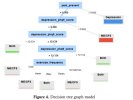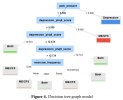Dolphin
Senior Member (Voting Rights)
Mental Health Diagnosis (Chronic Fatigue Syndrome and Depression) using Decision Tree Algorithm
Authors
- Ach. ZubairiUniversitas Ibrahimy, Indonesia
- Ahmad HomaidiUniversitas Ibrahimy, Indonesia
- Irma YunitaUniversitas Ibrahimy, Indonesia
- Jarot Dwi PrasetyoUniversitas Ibrahimy, Indonesia
- Hermanto HermantoUniversitas Ibrahimy, Indonesia
DOI:
https://doi.org/10.70609/g-tech.v9i3.7595Keywords:
Mental Health, Chronic Fatigue Syndrome, Depression, Decision TreeAbstract
Mental health is an important aspect that affects an individual's life, impacting productivity, social relationships and overall quality of life.The World Health Organization (WHO) states that one in four people worldwide will face mental health challenges.
With the increasing incidence of conditions such as depression and Chronic Fatigue Syndrome (CFS), effective detection and intervention methods are urgently needed.
Data mining, specifically using Decision Tree algorithms, presents a promising approach to address this challenge.
This study utilizes a quantitative methodology to classify depression and CFS patients using a public dataset.
The data collection from Kaggle included variables such as demographics and clinical evaluations, consisting of 1,000 records and 15 predictive attributes.
Data preprocessing addressed noise, specifically missing values, to ensure model accuracy above 80%.
A Decision Tree was implemented, displaying the interpretability of the method by partitioning the data based on the selected attributes.
Evaluation metrics such as accuracy, precision, recall, and F1 score showed accuracy of 99% and precision and recall of 100%.
The results emphasize the potential of the Decision Tree in distinguishing between depression and CFS, enabling early intervention through accurate patient identification.
This study advocates the integration of such machine learning models into clinical practice to improve mental health diagnostics and management, by addressing an important aspect of public health.


